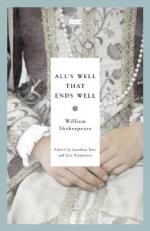|
This section contains 10,881 words (approx. 37 pages at 300 words per page) |

|
SOURCE: “Sacred and Sexual Motifs in All's Well That Ends Well,” in Renaissance Quarterly, Vol. 42, No. 1, Spring, 1989, pp. 33-59.
In the following essay, Simonds examines several matrimonial texts that were available to Shakespeare and his contemporaries in order demonstrate how Shakespeare's audience might have reacted to the characters of Bertram and Helena.
Whatever scholars may think of its value as a work of poetic literature, Shakespeare's All's Well That Ends Well is remarkably entertaining in the theater. Perhaps this is so because it fulfills the fundamental generic responsibility of comedy; it overcomes the death of the fathers through a bawdy emphasis on youthful sexuality and love, and it manipulates mythical plot elements that are subconsciously familiar to any audience in Western civilization. The play skillfully diverts our attention from death and burial to the “little death” of sexual orgasm, from age, illness, and the destruction of war to...
|
This section contains 10,881 words (approx. 37 pages at 300 words per page) |

|


